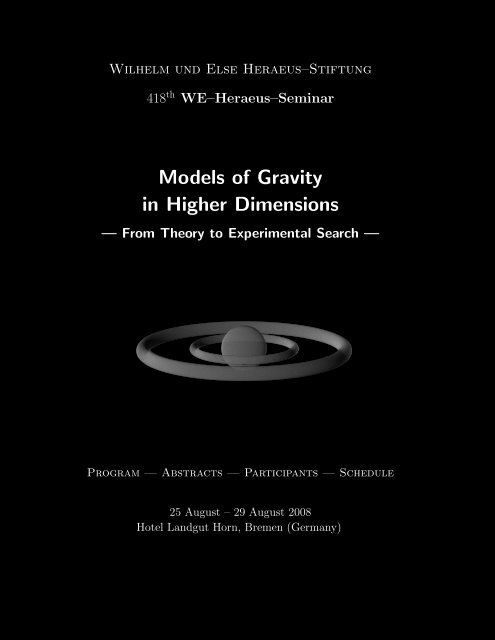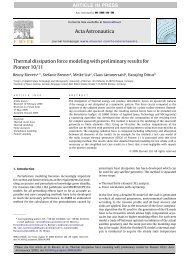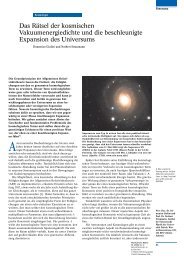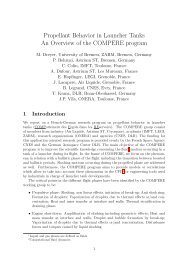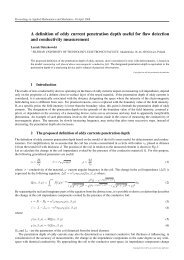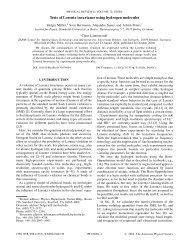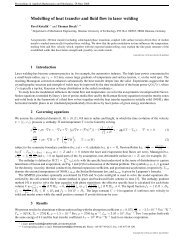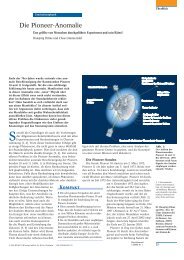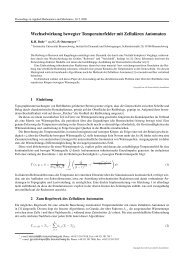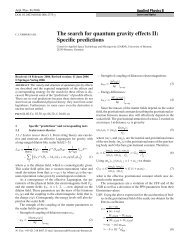What is the physics in higher dimensions? - ZARM
What is the physics in higher dimensions? - ZARM
What is the physics in higher dimensions? - ZARM
Create successful ePaper yourself
Turn your PDF publications into a flip-book with our unique Google optimized e-Paper software.
Wilhelm und Else Heraeus–Stiftung<br />
418 th WE–Heraeus–Sem<strong>in</strong>ar<br />
Models of Gravity<br />
<strong>in</strong> Higher Dimensions<br />
— From Theory to Experimental Search —<br />
Program — Abstracts — Participants — Schedule<br />
25 August – 29 August 2008<br />
Hotel Landgut Horn, Bremen (Germany)
The ”Wilhelm und Else Heraeus-Stiftung” <strong>is</strong> a private foundation which<br />
supports research and education <strong>in</strong> science, especially <strong>in</strong> <strong>physics</strong>. A major<br />
activity <strong>is</strong> <strong>the</strong> organ<strong>is</strong>ation of sem<strong>in</strong>ars. To German physic<strong>is</strong>ts <strong>the</strong> foundation<br />
<strong>is</strong> recognized as <strong>the</strong> most important private fund<strong>in</strong>g <strong>in</strong>stitution <strong>in</strong> <strong>the</strong>ir fields.<br />
Some activities of <strong>the</strong> foundation are carried out <strong>in</strong> cooperation with <strong>the</strong><br />
German Physical Society (Deutsche Physikal<strong>is</strong>che Gesellschaft).<br />
2
Aim and Purpose of <strong>the</strong><br />
418 th WE–Heraeus–Sem<strong>in</strong>ar<br />
Why <strong>higher</strong> <strong>dimensions</strong><br />
Start<strong>in</strong>g with Kaluza and Kle<strong>in</strong>, <strong>the</strong> unification of <strong>the</strong> fundamental <strong>in</strong>teractions<br />
has ever s<strong>in</strong>ce <strong>in</strong>volved <strong>higher</strong> <strong>dimensions</strong>. In particular, str<strong>in</strong>g <strong>the</strong>ory as<br />
a major candidate for such a unified <strong>the</strong>ory and thus also for quantum gravity,<br />
needs <strong>higher</strong> <strong>dimensions</strong> for its cons<strong>is</strong>tency. The additional <strong>dimensions</strong><br />
might be small and compact, but <strong>the</strong>re might also be large extra <strong>dimensions</strong>.<br />
Detection of <strong>the</strong>se would lead to excit<strong>in</strong>g new <strong>physics</strong> to be d<strong>is</strong>covered and<br />
lead to a new picture of <strong>the</strong> universe.<br />
Topics<br />
The ma<strong>in</strong> topics of th<strong>is</strong> sem<strong>in</strong>ar are<br />
• Solutions of E<strong>in</strong>ste<strong>in</strong> equations <strong>in</strong> <strong>higher</strong> <strong>dimensions</strong><br />
• Motion <strong>in</strong> <strong>higher</strong> dimensional space–times<br />
• Black holes <strong>in</strong> high energy particle coll<strong>is</strong>ion<br />
• Experimental search for <strong>higher</strong> <strong>dimensions</strong><br />
Lead<strong>in</strong>g experts <strong>in</strong> <strong>the</strong> field will give an overview of <strong>the</strong> whole subject.<br />
The sem<strong>in</strong>ar <strong>is</strong> devoted to diploma students, PhD students and researchers.<br />
3
Scientific Organization<br />
Prof. Dr. Jutta Kunz<br />
PD Dr. Claus Lämmerzahl<br />
Institute of Physics<br />
Carl von Ossietzky University Oldenburg<br />
Postfach 2503<br />
26111 Oldenburg<br />
Germany<br />
kunz@<strong>the</strong>orie.physik.uni-oldenburg.de<br />
<strong>ZARM</strong><br />
University of Bremen<br />
Am Fallturm<br />
28359 Bremen<br />
Germany<br />
laemmerzahl@zarm.uni-bremen.de<br />
4
Venue<br />
Place<br />
Meet<strong>in</strong>g room<br />
Reg<strong>is</strong>tration<br />
Conference e-mail<br />
Hotel Landgut Horn<br />
Leher Heerstraße 140<br />
28357 Bremen<br />
Germany<br />
Phone +49 (0) 421 25 89 0<br />
Fax +49 (0) 421 25 98 222<br />
<strong>in</strong>fo@landgut-horn.de<br />
Conference room<br />
Monday morn<strong>in</strong>g;<br />
Monday to Wednesday<br />
dur<strong>in</strong>g lunch and coffee breaks.<br />
laemmerzahl@zarm.uni-bremen.de<br />
5
7<br />
Program
Monday, 25 August 2008<br />
08:50 – 09:00 Welcome by Organizers and Heraeus foundation<br />
09:00 – 09:50 Hidden Symmetries of Higher Dimensional Black Holes I<br />
Valeri Frolov<br />
09:50 – 10:40 Str<strong>in</strong>g <strong>the</strong>ory: <strong>in</strong>troduction - status - outlook I<br />
Stefan The<strong>is</strong>en<br />
10:40 – 11:10 Coffee break<br />
11:10 – 12:00 Str<strong>in</strong>g <strong>the</strong>ory: <strong>in</strong>troduction - status - outlook II<br />
Stefan The<strong>is</strong>en<br />
12:00 – 12:50 Rotat<strong>in</strong>g black holes <strong>in</strong> <strong>higher</strong> <strong>dimensions</strong>:<br />
non–uniqueness, counterrotation and negative horizon mass<br />
Jutta Kunz<br />
12:50 – 15:00 Lunch<br />
15:00 – 15:50 Hidden Symmetries of Higher Dimensional Black Holes II<br />
Valeri Frolov<br />
15:50 – 16:40 Experimental Tests with Atomic Clocks I<br />
Eckehard Peik<br />
16:40 – 17:10 Coffee break<br />
17:10 – 18:00 Experimental Tests with Atomic Clocks II<br />
Eckehard Peik<br />
18:00 – 18:20 Higher dimensional Kerr-Schild spacetimes<br />
Marcello Ortaggio<br />
18:20 – 18:40 No <strong>higher</strong>-dimensional C-metric <strong>in</strong> <strong>the</strong> Rob<strong>in</strong>son-Trautman family<br />
Jiri Podolsky<br />
19:00 Social D<strong>in</strong>ner<br />
8
Tuesday, 26 August 2008<br />
09:00 – 09:50 Str<strong>in</strong>g <strong>the</strong>ory: <strong>in</strong>troduction - status - outlook III<br />
Stefan The<strong>is</strong>en<br />
09:50 – 10:40 Nonuniform Black Str<strong>in</strong>gs<br />
Burkhard Kleihaus<br />
10:40 – 11:10 Coffee break<br />
11:10 – 12:00 D-dimensional black holes and black str<strong>in</strong>gs <strong>in</strong> <strong>the</strong><br />
presence of a cosmological constant<br />
Yves Brihaye<br />
12:00 – 12:50 Gravitat<strong>in</strong>g non-Abelian solitons and hairy black holes<br />
<strong>in</strong> <strong>higher</strong> <strong>dimensions</strong><br />
Michael Volkov<br />
12:50 – 15:00 Lunch<br />
15:00 – 15:50 <strong>What</strong> <strong>is</strong> <strong>the</strong> <strong>physics</strong> <strong>in</strong> <strong>higher</strong> <strong>dimensions</strong><br />
Claus Lämmerzahl<br />
15:50 – 16:40 Tests of <strong>the</strong> gravitational <strong>in</strong>verse-square law:<br />
motivations, techniques and results I<br />
Eric Adelberger<br />
16:40 – 17:10 Coffee break<br />
17:10 – 18:00 Tests of <strong>the</strong> gravitational <strong>in</strong>verse-square law:<br />
motivations, techniques and results II<br />
Eric Adelberger<br />
18:00 – 18:20 Solitonic solution generat<strong>in</strong>g technique<br />
and black r<strong>in</strong>g solutions<br />
Hideo Iguchi<br />
18:20 – 18:40 The boundary counterterm method <strong>in</strong> E<strong>in</strong>ste<strong>in</strong>-Gauss-<br />
Bonnet <strong>the</strong>ory with negative cosmological constant<br />
Eugen Radu<br />
19:00 D<strong>in</strong>ner<br />
20:30 Poster session<br />
9
Wednesday, 27 August 2008<br />
09:00 – 09:50 Undeformed and deformed non-abelian black str<strong>in</strong>gs<br />
Betti Hartmann<br />
09:50 – 10:40 Black holes <strong>in</strong> Gauged Supergravity Theories I<br />
Miriam Cvetič<br />
10:40 – 11:10 Coffee break<br />
11:10 – 12:00 Black holes <strong>in</strong> Gauged Supergravity Theories II<br />
Miriam Cvetič<br />
12:00 – 12:50 On <strong>in</strong>tegrability and separability <strong>in</strong> <strong>the</strong> spacetimes<br />
of Kerr-NUT-(A)dS black holes<br />
Pavel Krtouš<br />
12:50 – 13:50 Lunch<br />
14:00 – 18:30 Excursion<br />
19:00 D<strong>in</strong>ner<br />
10
Thursday, 28 August 2008<br />
09:00 – 09:50 Black holes <strong>in</strong> Gauged Supergravity Theories III<br />
Miriam Cvetic<br />
09:50 – 10:40 Black Hole – Black Str<strong>in</strong>g Transition<br />
Barak Kol<br />
10:40 – 11:10 Coffee break<br />
11:10 – 12:00 Field Theory Methods <strong>in</strong> Gravitation<br />
Barak Kol<br />
12:00 – 12:50 M<strong>in</strong>i Black Holes: Will <strong>the</strong>y be created<br />
<strong>What</strong> can we learn from <strong>the</strong>m<br />
Panagiota Kanti<br />
12:50 – 15:00 Lunch<br />
15:00 – 15:50 M<strong>in</strong>i Black Holes: Will <strong>the</strong>y be created<br />
<strong>What</strong> can we learn from <strong>the</strong>m<br />
Panagiota Kanti<br />
15:50 – 16:40 Illum<strong>in</strong>at<strong>in</strong>g hidden sectors of nature<br />
Andreas R<strong>in</strong>gwald<br />
16:40 – 17:10 Coffee break<br />
17:10 – 18:00 Illum<strong>in</strong>at<strong>in</strong>g hidden sectors of nature<br />
Andreas R<strong>in</strong>gwald<br />
18:00 – 18:20 Charged black saturns<br />
Cr<strong>is</strong>tian Stelea<br />
18:20 – 18:40 Black hole formation <strong>in</strong> high-energy particle coll<strong>is</strong>ions<br />
Hirotaka Yosh<strong>in</strong>o<br />
19:00 D<strong>in</strong>ner<br />
11
Friday, 29 August 2008<br />
09:00 – 09:50 Static Solutions of Generalized E<strong>in</strong>ste<strong>in</strong>–Yang-Mills–Higgs Models<br />
Peter Breitenlohner<br />
09:50 – 10:40 Sigma-model approaches to exact solutions <strong>in</strong><br />
<strong>higher</strong>-dimensional gravity and supergravity I<br />
Gerard Clement<br />
10:40 – 11:10 Coffee break<br />
11:10 – 12:00 Sigma-model approaches to exact solutions <strong>in</strong><br />
<strong>higher</strong>-dimensional gravity and supergravity II<br />
Gerard Clement<br />
12:00 – 12:50 Gravitat<strong>in</strong>g Yang-Mills fields<br />
Tigran Tchrakian<br />
12:50 – 15:00 Lunch<br />
16:15 – 16:30 Coffee break – End of sem<strong>in</strong>ar<br />
19:00 D<strong>in</strong>ner<br />
12
13<br />
Abstracts
Tests of <strong>the</strong> gravitational <strong>in</strong>verse-square law: motivations,<br />
techniques and results<br />
Eric Adelberger<br />
(University of Wash<strong>in</strong>gton, Seattle)<br />
It <strong>is</strong> remarkable that small-scale experiments can address important open<br />
<strong>is</strong>sues <strong>in</strong> fundamental science such as: “why <strong>is</strong> gravity so weak” and “why<br />
<strong>is</strong> <strong>the</strong> cosmological constant so small” and “what <strong>is</strong> <strong>the</strong> real number of<br />
space <strong>dimensions</strong> <strong>in</strong> <strong>the</strong> Universe” Str<strong>in</strong>g <strong>the</strong>ory ideas (new scalar particles<br />
and extra <strong>dimensions</strong>) and o<strong>the</strong>r notions h<strong>in</strong>t that Newton’s Inverse-Square<br />
Law could break down: perhaps at d<strong>is</strong>tances less than 1 mm, perhaps at<br />
<strong>the</strong> astronomical scale. I will review <strong>the</strong> motivations for test<strong>in</strong>g <strong>the</strong> Inverse-<br />
Square Law, and d<strong>is</strong>cuss recent experiments with torsion balances and with<br />
laser-rang<strong>in</strong>g to <strong>the</strong> moon. Our torsion-balance experiments at separations<br />
down to 57 microns exclude gravitational-strength Yukawa <strong>in</strong>teractions with<br />
length scales greater than about 56 micrometers (approximately <strong>the</strong> diameter<br />
of a human hair), and set a robust 95% confidence upper limit of 44 micrometers<br />
on <strong>the</strong> size of an extra dimension. The APOLLO laser-rang<strong>in</strong>g facility<br />
<strong>is</strong> now provid<strong>in</strong>g lunar ranges with millimeter prec<strong>is</strong>ion, which will lead to<br />
substantial improvements <strong>in</strong> several key tests of <strong>the</strong> fundamental properties<br />
of gravity.<br />
[1] D.J. Kapner et al.: Phys. Rev. Lett. 98, 021101 (2007).<br />
[2] E.G. Adelberger et al.: Phys. Rev. Lett. 98, 13104 (2007).<br />
[3] N. Arkani-Hamed, S. Dimopoulos and G. Dvali: The Universe’s Unseen<br />
Dimensions, Scientific American, August 2000, Vol. 283 Issue 2.<br />
[4] E.G. Adelberger, B.R. Heckel and A.E. Nelson: Tests of <strong>the</strong> Gravitational<br />
Inverse Square Law, Annual Reviews of Nuclear and Particle<br />
Science 53, 77 (2003).<br />
[5] E.G. Adelberger, B.R. Heckel and C.D. Hoyle: Test<strong>in</strong>g <strong>the</strong> Gravitational<br />
Inverse-square Law, Physics World 18, 41-45 (April 2005).<br />
14
Static Solutions of Generalized E<strong>in</strong>ste<strong>in</strong>–Yang-Mills–<br />
Higgs Models<br />
Peter Breitenlohner<br />
(Werner-He<strong>is</strong>enberg-Institute, Munich)<br />
We study generalized Yang-Mill models with action ( ∧ p<br />
1 F )2 coupled to a<br />
Higgs field with action ( ∧ p−1<br />
1 FDΦ)2 <strong>in</strong> D =4p space-time <strong>dimensions</strong>. In<br />
flat space <strong>the</strong>se models have Bogomol’nyi solutions generaliz<strong>in</strong>g those for<br />
<strong>the</strong> p = 1 Prasad-Sommerfield monopole. When coupled to gravity with <strong>the</strong><br />
action ∧ p<br />
1 R <strong>the</strong>se models have static solutions ra<strong>the</strong>r similar to those of <strong>the</strong><br />
gravitat<strong>in</strong>g Prasad-Sommerfield monopole.<br />
[1] P. Breitenlohner, P. Forgács, and D. Ma<strong>is</strong>on: Nucl. Phys. B 442 (1995)<br />
126.<br />
[2] E. Radu, C. Stelea, and D. H. Tchrakian: arXiv:gr-qc/0601098.<br />
[5] E. Radu and D. H. Tchrakian: arXiv:hep-th/0502025.<br />
15
D-dimensional black holes and black str<strong>in</strong>gs <strong>in</strong> <strong>the</strong><br />
presence of a cosmological constant<br />
Yves Brihaye<br />
(Mons)<br />
It <strong>is</strong> known from some time that a cosmological constant can affect <strong>the</strong> physical<br />
properties of 4-dimensional solitons and sphalerons (and <strong>the</strong>ir black holes<br />
counterparts) once considered <strong>in</strong> <strong>the</strong> presence of gravity. Higher-dimensional<br />
gravity leads to much richer classes of new classical solutions than <strong>in</strong> four<strong>dimensions</strong>.<br />
In addition to black holes, black str<strong>in</strong>gs, black branes and black<br />
r<strong>in</strong>gs can be constructed. These solutions are to a large extend characterized<br />
by topology of <strong>the</strong>ir horizon. While some of <strong>the</strong>se solutions, e.g. black<br />
r<strong>in</strong>gs, can be constructed analytically <strong>in</strong> <strong>the</strong> case of an asymptotically flat<br />
space-time, <strong>the</strong> equations become untractable algebraically <strong>in</strong> <strong>the</strong> presence<br />
of a cosmological constant. The solutions can be constructed, however by<br />
us<strong>in</strong>g numerical methods. We will present several families of such solutions<br />
and d<strong>is</strong>cuss some of <strong>the</strong>ir aspects: coupl<strong>in</strong>g to electromagnet<strong>is</strong>m, to Yang-<br />
Mills, effect of a rotation and effect of a Gauss-Bonnet term. The stability<br />
of AdS black str<strong>in</strong>gs will also be d<strong>is</strong>cussed <strong>in</strong> relation with <strong>the</strong> Gubser-Mitra<br />
conjecture.<br />
[1] Y. Brihaye and E. Radu: Five-dimensional rotat<strong>in</strong>g black holes <strong>in</strong> E<strong>in</strong>ste<strong>in</strong>-<br />
Gauss-Bonnet <strong>the</strong>ory, arXiv:0801.1021 [hep-th] (to appear <strong>in</strong> Phys.<br />
Lett. B)<br />
[2] Y. Brihaye, T. Delsate, and E. Radu: On <strong>the</strong> stability of AdS black<br />
str<strong>in</strong>gs, arXiv:0710.4034 [hep-th]<br />
[3] Y. Brihaye, E. Radu, and D.H. Tchrakian: AdS 5 rotat<strong>in</strong>g non-Abelian<br />
black holes, Phys. Rev. D76, 105005 (2007), arXiv:0707.0552 [hep-th]<br />
[4] Y. Brihaye and E. Radu: Magnetic solutions <strong>in</strong> AdS 5 and trace anomalies,<br />
Phys. Lett. B658, 164 (2008), arXiv:0706.4378 [hep-th]<br />
[5] Y. Brihaye and T. Delsate: Charged-rotat<strong>in</strong>g black holes and black<br />
str<strong>in</strong>gs <strong>in</strong> <strong>higher</strong> dimensional E<strong>in</strong>ste<strong>in</strong>-Maxwell <strong>the</strong>ory with a positive<br />
cosmological constant, Class. Quant. Grav. 24, 4691 (2007), grqc/0703146<br />
[6] Y. Brihaye, E. Radu, and C. Stelea: Black str<strong>in</strong>gs with negative cosmological<br />
constant: Inclusion of electric charge and rotation, Class. Quant.<br />
Grav. 24, 4839 (2007), hep-th/0703046<br />
16
[7] Y. Brihaye and T. Delsate: Black str<strong>in</strong>gs and solitons <strong>in</strong> five dimensional<br />
space-time with positive cosmological constant, Phys. Rev. D75, 044013<br />
(2007), hep-th/0611195<br />
[8] Y. Brihaye, E. Radu, Eugen and D.H. Tchrakian: E<strong>in</strong>ste<strong>in</strong>-Yang-Mills<br />
solutions <strong>in</strong> <strong>higher</strong> dimensional de Sitter spacetime, Phys. Rev. D75,<br />
024022 (2007), gr-qc/0610087<br />
[9] Y. Brihaye and E. Radu: Kaluza-Kle<strong>in</strong> black holes with squashed horizons<br />
and d = 4 superposed monopoles, Phys. Lett. B641, 212 (2006),<br />
hep-th/0606228<br />
17
Sigma-model approaches to exact solutions <strong>in</strong> <strong>higher</strong>dimensional<br />
gravity and supergravity<br />
Gerard Clement<br />
(Annecy)<br />
Classical gravitat<strong>in</strong>g field <strong>the</strong>ories reduced to three <strong>dimensions</strong> admit manifest<br />
gauge <strong>in</strong>variances and hidden symmetries, which toge<strong>the</strong>r make up <strong>the</strong><br />
<strong>in</strong>variance group G of <strong>the</strong> <strong>the</strong>ory. If th<strong>is</strong> group <strong>is</strong> large enough, <strong>the</strong> target<br />
space <strong>is</strong> a symmetric space G/H. New solutions may be generated by <strong>the</strong><br />
action of <strong>in</strong>variance transformations on a seed solution. Ano<strong>the</strong>r application<br />
<strong>is</strong> <strong>the</strong> construction of multicenter solutions from null geodesics of <strong>the</strong> target<br />
space. After a general <strong>in</strong>troduction on th<strong>is</strong> sigma-model approach, I will<br />
d<strong>is</strong>cuss <strong>the</strong> case of five-dimensional gravity, with <strong>in</strong>variance group SL(3,R),<br />
and five-dimensional m<strong>in</strong>imal supergravity, with <strong>in</strong>variance group G 2 . I will<br />
<strong>the</strong>n summarize recent applications to <strong>the</strong> generation of new charged rotat<strong>in</strong>g<br />
black r<strong>in</strong>g solutions.<br />
[1] G. Clément: Solutions of five-dimensional general relativity without<br />
spatial symmetry, Gen. Rel. Grav. 18, 861 (1986).<br />
[2] G. Clément: From Schwarzschild to Kerr: generat<strong>in</strong>g sp<strong>in</strong>n<strong>in</strong>g E<strong>in</strong>ste<strong>in</strong>-<br />
Maxwell fields from static fields, Phys. Rev. D 57, 4885 (1998); grqc/9710109.<br />
[3] G. Clément and C. Leygnac: Non-asymptotically flat, non-AdS dilaton<br />
black holes, Phys. Rev. D 70, 084018 (2004); (gr-qc/0405034).<br />
[4] A.Bouchareb,C.M.Chen,G.Clément, D.V. Gal’tsov, N.G. Scherbluk<br />
and T. Wolf: G2 generat<strong>in</strong>g technique for m<strong>in</strong>imal D=5 supergravity<br />
and black r<strong>in</strong>gs, Phys. Rev. D 76, 104032 (2007); arXiv:0708.2361[hepth].<br />
[5] G. Clément: The symmetries of five-dimensional m<strong>in</strong>imal supergravity<br />
reduced to three <strong>dimensions</strong>, arXiv:0710.1192, J. Math. Phys. 49,<br />
042503 (2008); arXiv:0710.1192[gr-qc].<br />
18
Black holes <strong>in</strong> Gauged Supergravity Theories<br />
Miriam Cvetič<br />
(Philadelphia)<br />
We present general charged sp<strong>in</strong>n<strong>in</strong>g black holes <strong>in</strong> asymptotically antideSitter<br />
space-times <strong>in</strong> diverse <strong>dimensions</strong>. These are solutions of gauged<br />
supergravity <strong>the</strong>ories, i.e. effective <strong>the</strong>ories of cons<strong>is</strong>tent sphere reductions of<br />
str<strong>in</strong>g <strong>the</strong>ories. As such <strong>the</strong>se solutions play an important role <strong>in</strong> gauge <strong>the</strong>ory/gravity<br />
duality. Euclidean solutions and supersymmetric limits of such<br />
black holes are also presented.<br />
[1] M. Cvetič and J.F. Vazquez-Poritz: Warped Resolved L a,b,c Cones, ar-<br />
Xiv:0705.3847 [hep-th].<br />
[2] Z.W. Chong, M. Cvetič, H. Lu and C.N. Pope: Non-extremal rotat<strong>in</strong>g<br />
black holes <strong>in</strong> five-dimensional gauged supergravity, Phys. Lett. B 644,<br />
192 (2007) [arXiv:hep-th/0606213].<br />
[3] Z.W. Chong, M. Cvetič, H. Lu and C.N. Pope: General non-extremal<br />
rotat<strong>in</strong>g black holes <strong>in</strong> m<strong>in</strong>imal five-dimensional gauged supergravity,<br />
Phys. Rev. Lett. 95, 161301 (2005) [arXiv:hep-th/0506029].<br />
[4] M. Cvetič, H. Lu, D.N. Page and C.N. Pope: New E<strong>in</strong>ste<strong>in</strong>-Sasaki<br />
spaces <strong>in</strong> five and <strong>higher</strong> <strong>dimensions</strong>, Phys. Rev. Lett. 95, 071101 (2005)<br />
[arXiv:hep-th/0504225].<br />
19
Hidden Symmetries of Higher Dimensional Black<br />
Holes<br />
Valeri Frolov<br />
(Edmonton )<br />
The most general known solution describ<strong>in</strong>g <strong>higher</strong> dimensional rotat<strong>in</strong>g<br />
black holes with NUT parameters <strong>in</strong> an asymptotically (anti) de Sitter spacetime<br />
<strong>is</strong> a Kerr-NUT-(A)dS metric. We demonstrate that th<strong>is</strong> metric possesses<br />
a pr<strong>in</strong>cipal CKY tensor, that <strong>is</strong> a second rank closed conformal Kill<strong>in</strong>g-Yano<br />
tensor. Th<strong>is</strong> tensor generates a ‘tower’ of Kill<strong>in</strong>g-Yano and Kill<strong>in</strong>g tensors,<br />
which toge<strong>the</strong>r with <strong>the</strong> ex<strong>is</strong>t<strong>in</strong>g Kill<strong>in</strong>g vectors are sufficient for <strong>the</strong> complete<br />
<strong>in</strong>tegrability of geodesic equations and <strong>the</strong> separation of variables <strong>in</strong> <strong>the</strong><br />
Hamilton-Jacobi, Kle<strong>in</strong>-Gordon and Dirac equations. We also show that <strong>the</strong>se<br />
hidden symmetries, generated by <strong>the</strong> pr<strong>in</strong>cipal CKY tensor, allow one to<br />
solve <strong>the</strong> equations for a stationary str<strong>in</strong>g configurations and <strong>the</strong> equations<br />
for <strong>the</strong> parallel transport of <strong>the</strong> frame along geodesics <strong>in</strong> <strong>the</strong>se spacetimes.<br />
These ‘miraculous’ properties of <strong>the</strong> <strong>higher</strong> dimensional Kerr-NUT-(A)dS<br />
metrics make <strong>the</strong>m quite similar to <strong>the</strong> <strong>the</strong>ir 4-dimensional ‘cous<strong>in</strong>’.<br />
[1] V.P. Frolov and D. Kubiznak: Higher-Dimensional Black Holes: Hidden<br />
Symmetries and Separation of Variables, to appear <strong>in</strong> Class. Quant.<br />
Grav. arXiv:0802.0322 [hep-th],<br />
[1] P. Connell, V.P. Frolov, D. Kubiznak: Solv<strong>in</strong>g parallel transport equations<br />
<strong>in</strong> <strong>the</strong> <strong>higher</strong>-dimensional Kerr-NUT-(A)dS spacetimes. arXiv:0803.3259<br />
20
Undeformed and deformed non-abelian black str<strong>in</strong>gs<br />
Betti Hartmann<br />
(Bremen)<br />
Motivated by <strong>the</strong>ories <strong>in</strong> <strong>higher</strong> <strong>dimensions</strong> such as Kaluza-Kle<strong>in</strong> <strong>the</strong>ories,<br />
superstr<strong>in</strong>g <strong>the</strong>ories and brane world models, black holes <strong>in</strong> <strong>higher</strong> <strong>dimensions</strong><br />
have ga<strong>in</strong>ed a lot of <strong>in</strong>terest <strong>in</strong> recent years. A variety of different black<br />
hole solutions have been constructed and d<strong>is</strong>cussed such as hyperspherically<br />
symmetric black holes, black str<strong>in</strong>gs, black branes and black r<strong>in</strong>gs.<br />
While most solutions have been constructed <strong>in</strong> “pure” (dilaton-)gravity<br />
<strong>the</strong>ories, my talk will be concerned with <strong>higher</strong> dimensional black hole solutions<br />
<strong>in</strong> <strong>the</strong>ories where non-abelian gauge fields are m<strong>in</strong>imally coupled to<br />
gravity. I will mention hyperspherically symmetric black hole <strong>in</strong> 5 <strong>dimensions</strong><br />
with horizon topology S 3 (see [1]), but will ma<strong>in</strong>ly focus on so-called undeformed<br />
and deformed non-abelian black str<strong>in</strong>gs with horizon topology S 2 × S 1 .<br />
These solutions are translationally <strong>in</strong>variant and correspond to 4-dimensional<br />
(spherically or axially symmetric) non-abelian black holes trivially extended<br />
<strong>in</strong>to one extra <strong>dimensions</strong> [2,3,4].<br />
[1] Y. Brihaye, A. Chakrabarti, B. Hartmann and D.H. Tchrakian, Higher<br />
order curvature generalizations of Bartnick-McK<strong>in</strong>non and colored<br />
black hole solutions <strong>in</strong> D = 5, Phys. Lett. B 561, 161 (2003).<br />
[2] B. Hartmannm, Non-Abelian black str<strong>in</strong>gs, Phys. Lett. B 602, 231<br />
(2004).<br />
[3] Y. Brihaye and B. Hartmann, Deformed black str<strong>in</strong>gs <strong>in</strong> 5-dimensional<br />
E<strong>in</strong>ste<strong>in</strong>-Yang-Mills <strong>the</strong>ory, Class.Quant.Grav. 22, 5145 (2005).<br />
[4] Y. Brihaye, B. Hartmann and E. Radu, Black str<strong>in</strong>gs <strong>in</strong> (4+1)-dimensional<br />
E<strong>in</strong>ste<strong>in</strong>-Yang-Mills <strong>the</strong>ory, Phys.Rev. D 72, 104008 (2005).<br />
21
M<strong>in</strong>i Black Holes: Will <strong>the</strong>y be created <strong>What</strong> can<br />
we learn from <strong>the</strong>m<br />
Panagiota Kanti<br />
(Ioann<strong>in</strong>a)<br />
The new <strong>the</strong>ories that postulate <strong>the</strong> ex<strong>is</strong>tence of additional spacelike <strong>dimensions</strong><br />
<strong>in</strong> nature have given a new momentum to <strong>the</strong> study of black hole<br />
solutions <strong>in</strong> a <strong>higher</strong>-dimensional spacetime. The <strong>in</strong>troduction of <strong>the</strong> concept<br />
of <strong>the</strong> brane, as our 4-dimensional world embedded <strong>in</strong> a spacetime with one<br />
or more extra <strong>dimensions</strong>, has given r<strong>is</strong>e to new ideas, as well as to new<br />
problems, regard<strong>in</strong>g <strong>the</strong> ex<strong>is</strong>tence of cons<strong>is</strong>tent gravitational solutions, <strong>the</strong>ir<br />
<strong>in</strong>terpretation and potential observable effects for <strong>the</strong> local<strong>is</strong>ed-on-<strong>the</strong>-brane<br />
observer. While <strong>in</strong> <strong>the</strong> context of models with warped extra <strong>dimensions</strong> <strong>the</strong><br />
construction of analytical brane-world solutions has proven to be particularly<br />
challeng<strong>in</strong>g, <strong>in</strong> <strong>the</strong> presence of large extra <strong>dimensions</strong> <strong>the</strong> analys<strong>is</strong> may be<br />
significantly simplified under appropriate assumptions. Thus, <strong>the</strong> <strong>in</strong>terest has<br />
turned to phenomenological implications such as <strong>the</strong> possibility of <strong>the</strong> creation<br />
of a black hole dur<strong>in</strong>g a high-energy particle coll<strong>is</strong>ion, <strong>the</strong> modification<br />
of <strong>the</strong> decay process and its observable effects on our brane. In th<strong>is</strong> talk, I<br />
will briefly review <strong>the</strong> ma<strong>in</strong> developments <strong>in</strong> th<strong>is</strong> field of research.<br />
[1] P. Kanti: Black Holes at <strong>the</strong> LHC, arXiv:0802.2218 [hep-th].<br />
[2] P. Kanti: Black holes <strong>in</strong> <strong>the</strong>ories with large extra <strong>dimensions</strong>: A review,<br />
Int. J. Mod. Phys. A19 (2004) 4899 (hep-ph/0402168).<br />
[3] B. Webber: Black holes at accelerators, hep-ph/0511128.<br />
[4] T. Banks and W. F<strong>is</strong>chler: A model for high energy scatter<strong>in</strong>g <strong>in</strong> quantum<br />
gravity, hep-th/9906038.<br />
22
Nonuniform Black Str<strong>in</strong>gs<br />
Burkhard Kleihaus<br />
(Oldenburg)<br />
In D-dimesional space-time with some compact <strong>dimensions</strong> <strong>the</strong> vacuum solutions<br />
compr<strong>is</strong>e besides <strong>the</strong> black holes also black str<strong>in</strong>gs, if D>4. Whereas<br />
<strong>the</strong> black holes have horizon topology SD-2, <strong>the</strong> black str<strong>in</strong>gs have horizon<br />
topology S D−2 ×S 1 . Uniform black str<strong>in</strong>gs (UBS) are tranlationally <strong>in</strong>variant<br />
<strong>in</strong> direction of <strong>the</strong> compact dimension, but become unstable at <strong>the</strong> Gregory-<br />
Laflamme po<strong>in</strong>t. Nonuniform black str<strong>in</strong>gs (NUBS) emerge from <strong>the</strong> UBS<br />
at <strong>the</strong> Gregory-Laflamme po<strong>in</strong>t. The geometry of <strong>the</strong>ir horzion resembles a<br />
deformed cyl<strong>in</strong>der. In <strong>the</strong> limit of <strong>in</strong>f<strong>in</strong>ite deformation a topology chang<strong>in</strong>g<br />
configuration <strong>is</strong> expected, where <strong>the</strong> branchof<strong>the</strong>NUBSmergeswith<strong>the</strong><br />
branch of black holes.<br />
First NUBS <strong>in</strong> five and six <strong>dimensions</strong> will be considered and <strong>the</strong>ir physical<br />
properties d<strong>is</strong>cussed. Then we will focus on <strong>the</strong> <strong>in</strong>terior of <strong>the</strong> horzion of<br />
six dimensional NUBS. Next we will d<strong>is</strong>cuss <strong>the</strong> stationary rotat<strong>in</strong>g generelizations<br />
of NUBS. F<strong>in</strong>ally we will demonstrate how black str<strong>in</strong>g solutions of<br />
E<strong>in</strong>ste<strong>in</strong>-Maxwell-dilaton <strong>the</strong>ory can be generated from <strong>the</strong> vacuum solutions<br />
by a Harr<strong>is</strong>on transformation.<br />
23
Field Theory Methods <strong>in</strong> Gravitation<br />
Barak Kol<br />
(Jerusalem )<br />
Applications of Classical Effective Field Theory (CLEFT) methods to gravity<br />
are grow<strong>in</strong>g. In <strong>the</strong> talk, Feynman diagrams, regularization and renormalization<br />
will be applied to several gravitational problems <strong>in</strong>clud<strong>in</strong>g: matched<br />
asymptotic expansion and caged black holes; Post-Newtonian expansion<br />
(Non-Relativ<strong>is</strong>tic Gravitation) and b<strong>in</strong>ary system; and possibly o<strong>the</strong>rs to appear<br />
by <strong>the</strong> time of talk.<br />
[1] B. Kol and M. Smolk<strong>in</strong>: Classical Effective Field Theory and Caged<br />
Black Holes, arXiv:0712.2822<br />
[2] B. Kol and M. Smolk<strong>in</strong>: Non-Relativ<strong>is</strong>tic Gravitation: From Newton to<br />
E<strong>in</strong>ste<strong>in</strong> and Back, arXiv:0712.4116<br />
24
On <strong>in</strong>tegrability and separability <strong>in</strong> <strong>the</strong> spacetimes<br />
of Kerr-NUT-(A)dS black holes<br />
Pavel Krtouš<br />
(Praha)<br />
In <strong>the</strong> talk of V. Frolov we learn that <strong>the</strong> Kerr-NUT-(A)dS spacetime, describ<strong>in</strong>g<br />
a generally rotat<strong>in</strong>g black hole <strong>in</strong> <strong>higher</strong> dimension, <strong>is</strong> endowed with<br />
explicit and hidden symmetries encoded <strong>in</strong> <strong>the</strong> series of Kill<strong>in</strong>g vectors and<br />
Kill<strong>in</strong>g-Yano tensors. In th<strong>is</strong> talk we show how to use <strong>the</strong>se objects to construct<br />
a full set of commut<strong>in</strong>g <strong>in</strong>tegrals of motion for a geodesic motion and<br />
prove thus its complete <strong>in</strong>tegrability. Such an <strong>in</strong>tegrability <strong>is</strong> closely related<br />
to <strong>the</strong> separability of <strong>the</strong> Hamilton-Jacobi equation which also follows from<br />
<strong>the</strong> WKB approximation of <strong>the</strong> Kle<strong>in</strong>-Gordon equation. Us<strong>in</strong>g <strong>the</strong> secondrank<br />
Kill<strong>in</strong>g tensors related to <strong>the</strong> <strong>in</strong>tegrals of motion we are even able to<br />
construct a full set of commut<strong>in</strong>g symmetry operators of <strong>the</strong> Kle<strong>in</strong>-Gordon<br />
equation. The separability of <strong>the</strong> equations for eigenfunctions of <strong>the</strong>se operators<br />
<strong>is</strong> <strong>the</strong>n manifestly demonstrated by an explicit construction of <strong>the</strong><br />
common eigenfunctions. We also comment on <strong>the</strong> progress of f<strong>in</strong>d<strong>in</strong>g a general<br />
test electromagnetic field and, f<strong>in</strong>ally, give some remarks on a geometrical<br />
<strong>in</strong>terpretation of <strong>the</strong> Jacobi coord<strong>in</strong>ates <strong>in</strong> which <strong>the</strong> d<strong>is</strong>cussed separability<br />
have been achieved.<br />
[1] D.N. Page, D. Kubiznák, M. Vasudevan, and P. Krtouš: Complete Integrability<br />
of Geodesic Motion <strong>in</strong> General Higher-Dimensional Rotat<strong>in</strong>g<br />
Black Hole Spacetimes, Phys. Rev. Lett. 98 (2007) 061102, hepth/0611083<br />
[2] V.P. Frolov, P. Krtouš, and D. Kubiznák: Separability of Hamilton-<br />
Jacobi and Kle<strong>in</strong>-Gordon Equations <strong>in</strong> General Kerr-NUT-AdS Spacetimes,<br />
J. High Energy Phys. 0702 (2007) 5, hep-th/0611245<br />
[3] P. Krtouš, D. Kubiznák, D.N. Page, V.P. Frolov: Kill<strong>in</strong>g-Yano Tensors,<br />
Rank-2 Kill<strong>in</strong>g Tensors, and Conserved Quantities <strong>in</strong> Higher Dimensions,<br />
J. High Energy Phys. 0702 (2007) 4, hep-th/0612029<br />
[4] P. Krtous: Electromagnetic Field <strong>in</strong> Higher-Dimensional Black-Hole<br />
Spacetimes, Phys. Rev. D 76 (2007) 084035, arXiv:0707.0002<br />
[5] A. Sergyeyev, P. Krtouš: Complete Set of Commut<strong>in</strong>g Symmetry Operators<br />
for Kle<strong>in</strong>Gordon Equation <strong>in</strong> Generalized Higher-Dimensional<br />
Kerr-NUT-(A)dS Spacetimes, Phys. Rev. D 77 (2008) 044033, arXiv:0711.4623<br />
25
Rotat<strong>in</strong>g black holes <strong>in</strong> <strong>higher</strong> <strong>dimensions</strong>: non–<br />
uniqueness, counterrotation and negative horizon<br />
mass<br />
Jutta Kunz<br />
(Oldenburg)<br />
In D = 4 <strong>dimensions</strong> <strong>the</strong> Kerr-Newman solutions present <strong>the</strong> unique family of<br />
stationary asymptotically flat black holes of E<strong>in</strong>ste<strong>in</strong>-Maxwell (EM) <strong>the</strong>ory.<br />
The correspond<strong>in</strong>g D¿4 charged rotat<strong>in</strong>g black holes of EM <strong>the</strong>ory have not<br />
yet been obta<strong>in</strong>ed <strong>in</strong> closed form, but subsets have been obta<strong>in</strong>ed numerically,<br />
<strong>in</strong> particular, black holes <strong>in</strong> odd <strong>dimensions</strong> with equal-magnitude angular<br />
momenta. When a Chern-Simons (CS) term <strong>is</strong> added to <strong>the</strong> EM action, <strong>the</strong><br />
result<strong>in</strong>g stationary black hole solutions possess surpr<strong>is</strong><strong>in</strong>g properties. When<br />
<strong>the</strong> CS coefficient <strong>is</strong> <strong>in</strong>creased beyond its supergravity value, counterrotat<strong>in</strong>g<br />
black holes appear, whose horizon rotates <strong>in</strong> <strong>the</strong> opposite sense to <strong>the</strong> angular<br />
momentum. Black holes may also possess a negative horizon mass, while<br />
<strong>the</strong>ir total mass <strong>is</strong> positive. Moreover black holes are no longer uniquely<br />
characterized by <strong>the</strong>ir global charges. F<strong>in</strong>ally, charged rotat<strong>in</strong>g black holes<br />
with negative cosmological constant are d<strong>is</strong>cussed.<br />
[1] J. Kunz, F. Navarro-Lérida, and A. K. Petersen: Five-Dimensional<br />
Charged Rotat<strong>in</strong>g Black Holes, Phys. Lett. B614, 104 (2005), gr-qc/0503010.<br />
[2] J. Kunz, F. Navarro-Lrida: D=5 E<strong>in</strong>ste<strong>in</strong>-Maxwell-Chern-Simons Black<br />
Holes, Phys. Rev. Lett. 96, 081101 (2006), hep-th/0510250.<br />
[3] J. Kunz, D. Ma<strong>is</strong>on, F. Navarro-Lérida, and J. Viebahn: Rotat<strong>in</strong>g<br />
E<strong>in</strong>ste<strong>in</strong>-Maxwell-Dilaton Black Holes <strong>in</strong> D Dimensions, Phys. Lett.<br />
B639, 95 (2006), hep-th/0606005.<br />
[4] J.Kunz,F.Navarro-Lérida, and J. Viebahn: Charged Rotat<strong>in</strong>g Black<br />
Holes <strong>in</strong> Odd Dimensions, Phys. Lett. B639, 362 (2006), hep-th/0605075<br />
[5] J.Kunz,F.Navarro-Lérida: Negative Horizon Mass for Rotat<strong>in</strong>g Black<br />
Holes, Phys. Lett. B643, 55 (2006), hep-th/0610036.<br />
[6] J.Kunz,F.Navarro-Lérida: Non-Uniqueness, Counterrotation, and Negative<br />
Horizon Mass of E<strong>in</strong>ste<strong>in</strong>-Maxwell-Chern-Simons Black Holes,<br />
Mod. Phys. Lett. A21, 2621 (2006), hep-th/0610075.<br />
[7] J.Kunz,F.Navarro-Lérida, and E. Radu: Higher Dimensional Rotat<strong>in</strong>g<br />
Black Holes <strong>in</strong> E<strong>in</strong>ste<strong>in</strong>-Maxwell Theory with Negative Cosmological<br />
Constant, Phys. Lett. B649 463 (2007), gr-qc/0702086.<br />
26
<strong>What</strong> <strong>is</strong> <strong>the</strong> <strong>physics</strong> <strong>in</strong> <strong>higher</strong> <strong>dimensions</strong><br />
Claus Lämmerzahl<br />
(Bremen)<br />
Usually physical laws are transscribed to <strong>higher</strong> <strong>dimensions</strong> by leav<strong>in</strong>g Gauss’<br />
law or similar features unchanged [1,2]. Th<strong>is</strong> leads to modifications of <strong>the</strong><br />
<strong>in</strong>teraction potentials like Newton or Coulomb potential or <strong>the</strong> space-time<br />
metric <strong>in</strong> <strong>higher</strong> <strong>dimensions</strong>. Here we proceed ano<strong>the</strong>r way: If we assume<br />
that, e.g., <strong>the</strong> Keplerian motions are <strong>the</strong>same<strong>in</strong><strong>higher</strong><strong>dimensions</strong>,<strong>the</strong>n<br />
<strong>the</strong> gravitational potential <strong>in</strong> <strong>higher</strong> dimension should have <strong>the</strong> same form<br />
as <strong>in</strong> three <strong>dimensions</strong>. Th<strong>is</strong> asks for a modification of <strong>the</strong> gravitational field<br />
equation which now has to be of pseudo-differential operator form [3]. We<br />
determ<strong>in</strong>e <strong>the</strong> field equations and d<strong>is</strong>cuss observational consequences. We<br />
also d<strong>is</strong>cuss o<strong>the</strong>r observational criteria like Huygens pr<strong>in</strong>ciple which depend<br />
on <strong>the</strong> dimensionality of space-time [4].<br />
[1] P. Ehrenfest: Welche Rolle spielt die Dimensionalitt des Raumes <strong>in</strong> den<br />
Grundgesetzen der Physik, Ann. Phys. (Leipzig) 61, 440 (1920).<br />
[1] J. D. Barrow: Dimensionality, Philos. Trans. R. Soc. London, Ser. A<br />
310, 337 (1983).<br />
[1] F. Burgbacher, C. Lämmerzahl, A. Macias: Is <strong>the</strong>re a stable hydrogen<br />
atom <strong>in</strong> <strong>higher</strong> <strong>dimensions</strong>, J. Math. Phys. 40, 625 (1999).<br />
[1] C. Lämmerzahl, A. Macias: On <strong>the</strong> Dimensionality of Space-Time, J.<br />
Math. Phys. 34, 4540 (1993).<br />
27
Experimental Tests with Atomic Clocks<br />
Ekkehard Peik<br />
(PTB Braunschweig)<br />
Atomic clocks are <strong>the</strong> most prec<strong>is</strong>e measur<strong>in</strong>g devices constructed by mank<strong>in</strong>d<br />
and consequently <strong>the</strong>y play a prom<strong>in</strong>ent role <strong>in</strong> experimental tests of<br />
Relativity and <strong>in</strong> a search for New Physics. I will review recent tests of aspects<br />
of <strong>the</strong> equivalence pr<strong>in</strong>ciple like searches for violation of local position <strong>in</strong>variance<br />
or temporal variations of fundamental constants with atomic clocks of<br />
different k<strong>in</strong>d.<br />
[1] S.G. Karshenboim and E. Peik (Eds.): Astro<strong>physics</strong>, Clocks and Fundamental<br />
Constants, Lecture Notes <strong>in</strong> Physics , Vol. 648 (Spr<strong>in</strong>ger,<br />
Heidelberg, 2004)<br />
[2] S.G. Karshenboim, V. Flambaum, and E. Peik: Atomic Clocks and<br />
Constra<strong>in</strong>ts on Variations of Fundamental Constants, arXiv:<strong>physics</strong>/0410074<br />
[3] P. Wolf et al.: Quantum Physics Explor<strong>in</strong>g Gravity <strong>in</strong> <strong>the</strong> Outer Solar<br />
System: The Sagas Project, arXiv:0711.0304<br />
28
Illum<strong>in</strong>at<strong>in</strong>g hidden sectors of nature<br />
Andreas R<strong>in</strong>gwald<br />
(DESY Hamburg)<br />
Most embedd<strong>in</strong>gs of <strong>the</strong> standard model <strong>in</strong>to a more unified <strong>the</strong>ory, <strong>in</strong> particular<br />
<strong>the</strong> ones based on supergravity or superstr<strong>in</strong>gs, predict <strong>the</strong> ex<strong>is</strong>tence<br />
of a hidden sector of particles and <strong>in</strong>teractions which have only very weak<br />
<strong>in</strong>teractions with <strong>the</strong> v<strong>is</strong>ible sector standard model particles. The gauge <strong>in</strong>teractions<br />
<strong>in</strong> <strong>the</strong> hidden sector generically <strong>in</strong>volve several U(1) factors. Usually,<br />
it <strong>is</strong> assumed that <strong>the</strong> correspond<strong>in</strong>g gauge bosons are very heavy, <strong>in</strong> order to<br />
avoid eventual bservational constra<strong>in</strong>ts from low energy experiments. However,<br />
<strong>in</strong> real<strong>is</strong>tic str<strong>in</strong>g compactifications, some of <strong>the</strong>se hidden photons may<br />
<strong>in</strong>deed be light, with masses <strong>in</strong> <strong>the</strong> sub-eV range. In th<strong>is</strong> case, <strong>the</strong> dom<strong>in</strong>ant<br />
<strong>in</strong>teraction with <strong>the</strong> v<strong>is</strong>ible sector photon will be through gauge k<strong>in</strong>etic<br />
mix<strong>in</strong>g. Moreover, hidden sector matter particles charged under such U(1)s<br />
will acquire some effective electric charge proportional to <strong>the</strong> k<strong>in</strong>etic mix<strong>in</strong>g<br />
angle. Correspond<strong>in</strong>gly, such light hidden sector particles may be searched<br />
for <strong>in</strong> experiments exploit<strong>in</strong>g high fluxes of low energy photons and/or large<br />
electromagnetic fields. We will present a review of th<strong>is</strong> emerg<strong>in</strong>g low energy<br />
frontier of fundamental <strong>physics</strong>.<br />
[1] H. Gies, J. Jaeckel and A. R<strong>in</strong>gwald: Polarized light propagat<strong>in</strong>g <strong>in</strong> a<br />
magnetic field as a probe of millicharged fermions, Phys. Rev. Lett. 97,<br />
140402 (2006). arXiv:hep-ph/0607118<br />
[2] H. Gies, J. Jaeckel and A. R<strong>in</strong>gwald: Accelerator cavities as a probe<br />
of millicharged particles, Europhys. Lett. 76, 794 (2006). arXiv:hepph/0608238<br />
[3] S.A. Abel, J. Jaeckel, V.V. Khoze and A. R<strong>in</strong>gwald: Illum<strong>in</strong>at<strong>in</strong>g <strong>the</strong><br />
hidden sector of str<strong>in</strong>g <strong>the</strong>ory by sh<strong>in</strong><strong>in</strong>g light through a magnetic field,<br />
Phys. Lett. B (2008) (<strong>in</strong> pr<strong>in</strong>t). arXiv:hep-ph/0608248<br />
[4] M. Ahlers, H. Gies, J. Jaeckel and A. R<strong>in</strong>gwald: On <strong>the</strong> particle <strong>in</strong>terpretation<br />
of <strong>the</strong> PVLAS data: Neutral versus charged particles, Phys.<br />
Rev. D 75, 035011 (2007). arXiv:hep-ph/0612098<br />
[5] M. Ahlers, H. Gies, J. Jaeckel, J. Redondo and A. R<strong>in</strong>gwald: Light from<br />
<strong>the</strong> Hidden Sector, Phys. Rev. D 76, 115005 (2007). arXiv:0706.2836<br />
[hep-ph]<br />
[6] J. Jaeckel and A. R<strong>in</strong>gwald: A Cavity Experiment to Search for Hidden<br />
Sector Photons, Phys. Lett. B 659, 509 (2008). arXiv:0707.2063 [hepph]<br />
29
[7] A. L<strong>in</strong>dner and A. R<strong>in</strong>gwald: The Low-Energy Frontier, Phys. World<br />
20N8, 32 (2007)<br />
[8]M.Ahlers,H.Gies,J.Jaeckel,J.RedondoandA.R<strong>in</strong>gwald:Laser<br />
experiments explore <strong>the</strong> hidden sector, Phys. Rev. D (2008) (<strong>in</strong> pr<strong>in</strong>t).<br />
arXiv:0711.4991 [hep-ph]<br />
[9] S.A. Abel, M.D. Goodsell, J. Jaeckel, V.V. Khoze and A. R<strong>in</strong>gwald:<br />
K<strong>in</strong>etic Mix<strong>in</strong>g of <strong>the</strong> Photon with Hidden U(1)s <strong>in</strong> Str<strong>in</strong>g Phenomenology,<br />
arXiv:0803.1449 [hep-ph]<br />
30
Gravitat<strong>in</strong>g Yang-Mills fields<br />
Tigran Tchrakian<br />
(Dubl<strong>in</strong>)<br />
Review of work on <strong>the</strong> extension of gravitat<strong>in</strong>g Yang-Mills solutions to arbitrary<br />
<strong>dimensions</strong>. The <strong>higher</strong> dimensional gauge field systems <strong>in</strong>volved necessarily<br />
<strong>in</strong>clude <strong>higher</strong> order terms <strong>in</strong> <strong>the</strong> Yang-Mills curvature, while <strong>the</strong><br />
correspond<strong>in</strong>g gravitational systems <strong>in</strong>volved can be restricted to <strong>the</strong> usual<br />
E<strong>in</strong>ste<strong>in</strong>-Hilbert actions. Exerc<strong>is</strong><strong>in</strong>g <strong>the</strong> option of employ<strong>in</strong>g gravitational<br />
systems that are <strong>higher</strong> order <strong>in</strong> <strong>the</strong> Riemann curvature however result <strong>in</strong><br />
solutions with particularly <strong>in</strong>terest<strong>in</strong>g properties.<br />
[1] E. Radu, D.H. Tchrakian, Y. Yang: Spherically symmetric selfdual<br />
Yang-Mills <strong>in</strong>stantons on curved backgrounds <strong>in</strong> all even <strong>dimensions</strong>.<br />
Phys. Rev. D 77, 044017 (2008), arXiv:0707.1270 [hep-th]<br />
[2] E. Radu, Ya. Shnir, D.H. Tchrakian: d=4+1 gravitat<strong>in</strong>g nonabelian<br />
solutions with bi-azimuthal symmetry. Phys. Lett. B 657, 246 (2007),<br />
arXiv:0705.3608 [hep-th]<br />
[3] P. Breitenlohner, D. Ma<strong>is</strong>on, D.H. Tchrakian: Regular solutions to <strong>higher</strong><br />
order curvature E<strong>in</strong>ste<strong>in</strong>-Yang-Mills systems <strong>in</strong> <strong>higher</strong> <strong>dimensions</strong>,<br />
Class. Quantum Grav. 22, 5201 (2005), gr-qc/0508027<br />
[4] Y.Brihaye,A.Chakrabarti,B.Hartmann, D.H. Tchrakian: Higher order<br />
curvature generalizations of Bartnick-McK<strong>in</strong>non and colored black<br />
hole solutions <strong>in</strong> D = 5, Phys. Lett. B 561, 161 (2003), hep-th/0212288<br />
[5] Y. Brihaye, A. Chakrabarti, D.H. Tchrakian: Particle - like solutions<br />
to <strong>higher</strong> order curvature E<strong>in</strong>ste<strong>in</strong>-Yang-Mills systems <strong>in</strong> d-<strong>dimensions</strong>,<br />
Class. Quantum Grav. 20, 2765 (2003), hep-th/0202141<br />
31
Str<strong>in</strong>g <strong>the</strong>ory: <strong>in</strong>troduction - status - outlook<br />
Stefan The<strong>is</strong>en<br />
(Golm)<br />
No abstract<br />
32
Gravitat<strong>in</strong>g non-Abelian solitons and hairy black<br />
holes <strong>in</strong> <strong>higher</strong> <strong>dimensions</strong><br />
Michael Volkov<br />
(Tours)<br />
A short review of classical solutions with gravitat<strong>in</strong>g Yang-Mills fields, with<br />
or without supersymmetry.<br />
[1] M.S.Volkov, hep-th/0612219<br />
[2] D.V. Gal’tsov, E.A. Davydov and M.S. Volkov, Phys. Lett. B 648, 249<br />
(2007).<br />
[3] A. Chamsedd<strong>in</strong>e and M.S.Volkov, Phys. Rev. D 70, 086007 (2004).<br />
33
Short talks<br />
Solitonic solution generat<strong>in</strong>g technique and black r<strong>in</strong>g solutions<br />
Hideo Iguchi (Chiba)<br />
Higher dimensional Kerr-Schild spacetimes<br />
Marcello Ortaggio (Prague)<br />
No <strong>higher</strong>-dimensional C-metric <strong>in</strong> <strong>the</strong> Rob<strong>in</strong>son-Trautman family<br />
Jiri Podolsky (Prague)<br />
E<strong>in</strong>ste<strong>in</strong>-Gauss-Bonnet <strong>the</strong>ory with negative cosmological constant and<br />
<strong>the</strong> boundary counterterm method<br />
Eugen Radu (Tours)<br />
Charged black saturns<br />
Cr<strong>is</strong>tian Stelea (Vancouver)<br />
Black hole formation <strong>in</strong> high-energy particle coll<strong>is</strong>ions<br />
Hirotaka Yosh<strong>in</strong>o (Edmonton)<br />
34
Posters<br />
Black Hole Formation <strong>in</strong> High-Energy Particle Coll<strong>is</strong>ions<br />
Hirotaka Yosh<strong>in</strong>o (University of Alberta, Canada)<br />
Five-Dimensional Black Hole Capture Cross Sections<br />
C<strong>is</strong>co Good<strong>in</strong>g, Andrei Frolov (Department of Physics, Simon Fraser University<br />
)<br />
D<strong>is</strong>tored Weyl Solutions <strong>in</strong> Higher Dimensions<br />
Shohreh Abdolrahimi, Andrey A. Shoom (Department of Physics, University<br />
of Alberta, Canada)<br />
Gravitational Wave Contributions to Entropy Fluctuations <strong>in</strong> Early Inflationary<br />
Cosmology<br />
Andrew W. Beckwith (Fermi Lab)<br />
Photon Capture <strong>in</strong> a Rotat<strong>in</strong>g Dilaton Black Hole<br />
Kenta Hioki (Department of Physics, Waseda University, Japan)<br />
Umpei Miyamoto (Racah Institute of Physics, Hebrew University=<br />
Quas<strong>in</strong>ormal Modes of Black Holes Localized on <strong>the</strong> Randall-Sundrum<br />
2-brane<br />
Masato Nozawa, Tsutomu Kobayashi (Waseda University, Japan)<br />
35
37<br />
Participants
L<strong>is</strong>t of participants<br />
Name, Title First name Address<br />
Abdolrahimi Shohreh University of Alberta<br />
CEB, 11322-89 Ave, Physics Department<br />
University of Alberta, Edmonton, Alberta, Canada, T6G 2G7<br />
Adelberger Eric Center for Experimental Nuclear Physics and Astro<strong>physics</strong>,<br />
University of Wash<strong>in</strong>gton,<br />
Seattle, WA, 98195<br />
USA<br />
Balcerzak Adam Univer<strong>is</strong>ty of Szczec<strong>in</strong> Wielkopolska 15,<br />
Szczec<strong>in</strong>,<br />
Poland.<br />
Beckwith Andrew Fermi National Laboratory<br />
USA<br />
Breitenlohner Peter Max-Planck-Institut für Physik<br />
(Werner-He<strong>is</strong>enberg-Institut)<br />
Föhr<strong>in</strong>ger R<strong>in</strong>g 6<br />
D-80805 München<br />
Germany<br />
Breuer He<strong>in</strong>z-Peter Hanse-W<strong>is</strong>senschaftkolleg Delmenhorst<br />
Delmenhorst<br />
Germany<br />
Brihaye Yves Faculté des Sciences<br />
Université de Mons-Ha<strong>in</strong>aut<br />
7000 Mons<br />
Belgium<br />
Chakrabarti Amitabha Centre de Physique Théorique<br />
Ecole Polytechnique<br />
91128 Pala<strong>is</strong>eau Cedex<br />
France<br />
Clement Garard Laboratoire de Physique Theorique LAPTH<br />
BP 110<br />
74941 Annecy-le-Vieux cedex<br />
France<br />
Cvetic Mirjam Department of Physics and Astronomy<br />
University of Pennsylvania<br />
Philadelphia<br />
USA<br />
Dittus Hansjörg <strong>ZARM</strong><br />
University of Bremen<br />
Am Fallturm<br />
20359 Bremen<br />
Germany<br />
Frolov Valeri Department of Physics<br />
University of Alberta<br />
Edmonton AB Canada<br />
T6G 2J1<br />
Canada<br />
Giul<strong>in</strong>i Domenico Max-Planck-Institut für Gravitationsphysik<br />
Albert-E<strong>in</strong>ste<strong>in</strong>-Institut<br />
Am MÜhlenberg 1<br />
14476 Golm<br />
Germany
Göklü Ertan <strong>ZARM</strong><br />
University of Bremen<br />
Am Fallturm<br />
20359 Bremen<br />
Germany<br />
Good<strong>in</strong>g C<strong>is</strong>co Simon Fraser University<br />
8888 University Drive<br />
Burnaby, B.C., V5A 1S6<br />
Canada<br />
Hackmann Eva <strong>ZARM</strong><br />
University of Bremen<br />
Am Fallturm<br />
20359 Bremen<br />
Germany<br />
hackmann@zarm.uni-bremen.de<br />
Hartmann Betti School of Eng<strong>in</strong>eer<strong>in</strong>g and Science<br />
Jacobs University Bremen<br />
Research III, Room 66<br />
28759 Bremen<br />
Germany<br />
Hioki Kenta Dept. of Physics, Waseda University<br />
3-4-1-#55N-307 Okubo,<br />
Sh<strong>in</strong>juku-ku,<br />
Tokyo 169-8555<br />
Japan<br />
Iguchi Hideo Nihon University<br />
Narash<strong>in</strong>odai,<br />
Funabashi,<br />
Chiba 274-8501,<br />
Japan<br />
Jakimowicz Malgorzata University of Warsaw, Institute of Theoretical Physics<br />
Hoza 69<br />
00-681 Warsaw<br />
Poland<br />
Kagramanova Valeria Department of Physics<br />
Carl von Ossietzky University Oldenburg<br />
26111 Oldenburg<br />
Germany<br />
Kanti Panagiota Department of Physics<br />
University of Ioann<strong>in</strong>a<br />
Ioann<strong>in</strong>a GR-45110<br />
Greece<br />
Kleihaus Burkhard Department of Physics<br />
Carl von Ossietzky University Oldenburg<br />
26111 Oldenburg<br />
Germany<br />
Kol Barak Racah Institute of Physics<br />
Hebrew University<br />
Jerusalem 91904<br />
Israel<br />
Krtous Pavel Institute of Theoretical Physics<br />
Faculty of Ma<strong>the</strong>matics and Physics<br />
Charles University <strong>in</strong> Prague<br />
V Holešovickách 2<br />
180 00 Prague 8<br />
Czech Republic<br />
Kunz Jutta Department of Physics<br />
Carl von Ossietzky University Oldenburg<br />
26111 Oldenburg<br />
Germany<br />
kunz@<strong>the</strong>orie.physik.uni-oldenburg.de
Lämmerzahl Claus <strong>ZARM</strong><br />
University of Bremen<br />
Am Fallturm<br />
20359 Bremen<br />
Germany<br />
laemmerzahl@zarm.uni-bremen.de<br />
Lechtenfeld Olaf Institute for Theoretcial Physics<br />
Leibniz University Hannover<br />
Appelstr. 2<br />
30167 Hannover<br />
Germany<br />
Le<strong>is</strong>sner Daniel Department of Physics<br />
Carl von Ossietzky University Oldenburg<br />
26111 Oldenburg<br />
Germany<br />
L<strong>is</strong>t meike <strong>ZARM</strong><br />
University of Bremen<br />
Am Fallturm<br />
20359 Bremen<br />
Germany<br />
Lorek Denn<strong>is</strong> <strong>ZARM</strong><br />
University of Bremen<br />
Am Fallturm<br />
20359 Bremen<br />
Germany<br />
Nozawa Masato Waseda University<br />
55N-307, Department of Physics<br />
Okubo 3-4-1<br />
Sh<strong>in</strong>juku-ku<br />
Tokyo 169-8555<br />
Japan<br />
Ortaggio Marcello Institute of Theoretical Physics<br />
Faculty of Ma<strong>the</strong>matics and Physics<br />
Charles University <strong>in</strong> Prague<br />
V Holešovickách 2<br />
180 00 Prague 8<br />
Czech Republic<br />
Peik Eckehard Physikal<strong>is</strong>ch-Techn<strong>is</strong>che Bundesanstalt<br />
FB 4.4 Time and Frequency<br />
Bundesallee 100<br />
38116 Braunschweig<br />
Germany<br />
Podolsky Jiri Institute of Theoretical Physics<br />
Faculty of Ma<strong>the</strong>matics and Physics<br />
Charles University <strong>in</strong> Prague<br />
V Holešovickách 2<br />
180 00 Prague 8<br />
Czech Republic<br />
Pravda Vojtech Institute of Theoretical Physics<br />
Faculty of Ma<strong>the</strong>matics and Physics<br />
Charles University <strong>in</strong> Prague<br />
V Holešovickách 2<br />
180 00 Prague 8<br />
Czech Republic<br />
Rademaker Patricia <strong>ZARM</strong><br />
University of Bremen<br />
Am Fallturm<br />
20359 Bremen<br />
Germany
Radu Eugen Laboratoire de Ma<strong>the</strong>matiques et Physique Theorique<br />
Universite Franco<strong>is</strong>-Rabela<strong>is</strong><br />
Tours<br />
France<br />
Resch Andreas <strong>ZARM</strong><br />
University of Bremen<br />
Am Fallturm<br />
20359 Bremen<br />
Germany<br />
R<strong>in</strong>gwald Andreas Theory Group<br />
DESY<br />
Notkestraße 85<br />
22603 Hamburg<br />
Germany<br />
Sarkar Sudipta Inter-University Centre for Astronomy and Astro<strong>physics</strong><br />
IUCAA<br />
Post Bag 4<br />
Ganeshkh<strong>in</strong>d<br />
Pune University Campus<br />
Pune 411 007<br />
India<br />
Schaffer Isabell <strong>ZARM</strong><br />
University of Bremen<br />
Am Fallturm<br />
20359 Bremen<br />
Germany<br />
schaffer@zarm.uni-bremen.de<br />
Shimon Rub<strong>in</strong> Ben Gurion University<br />
Be'er Sheva 84105<br />
Israel<br />
Shoom Andrey University of Alberta<br />
CEB, 11322-89Ave,<br />
Edmonton, Alberta,<br />
T6G 2G7<br />
Canada<br />
Smolk<strong>in</strong> M<strong>is</strong>ha Racah Institute of Physics<br />
Hebrew University<br />
Jerusalem 91904<br />
Israel.<br />
Stelea Cr<strong>is</strong>tian University of Brit<strong>is</strong>h Columbia<br />
6224 Agricultural Road, Vancouver, BC<br />
Canada<br />
Tchrakian Tigran Department of Ma<strong>the</strong>matical Physics<br />
National University of Ireland<br />
Maynooth<br />
Ireland<br />
The<strong>is</strong>en Stefan Max-Planck-Institut für Gravitationsphysik<br />
Albert-E<strong>in</strong>ste<strong>in</strong>-Institut<br />
Am MÜhlenberg 1<br />
14476 Golm<br />
Germany<br />
Volkov Michael Laboratoire de Mathématiques et Physique Théorique<br />
CNRS-UMR 6083,<br />
Université de Tours<br />
Parc de Grandmont<br />
37200 Tours<br />
France<br />
Yosh<strong>in</strong>o Hirotaka Department of Physics<br />
University of Alberta<br />
Edmonton, Alberta, T6G 2G7<br />
Canada
Monday Tuesday Wednesday Thursday Friday<br />
08:50 - 09:00 Welcome<br />
09:00 - 09:50 Frolov The<strong>is</strong>en Hartmann Cvetic Breitenlohner<br />
09:50 - 10:40 The<strong>is</strong>en Kleihaus Cvetic Kol Clement<br />
10:40 - 11:10 coffee coffee coffee coffee coffee<br />
11:10 - 12:00 The<strong>is</strong>en Brihaye Cvetic Kol Clement<br />
12:00 - 12:50 Kunz Volkov Krtous Kanti Tchrakian<br />
12:50 - 15:00 lunch lunch lunch lunch lunch<br />
15:00 - 15:50 Frolov Laemmerzahl<br />
Kanti D<strong>is</strong>cussion<br />
15:50 - 16:40 Peik Adelberger R<strong>in</strong>gwald D<strong>is</strong>cussion<br />
16:40 - 17:10 coffee coffee excursion coffee coffee<br />
17:10 - 18:00 Peik Adelberger R<strong>in</strong>gwald departure<br />
18:00 - 18:50 2 short talks 2 short talks 2 short talks<br />
19:00 social d<strong>in</strong>ner d<strong>in</strong>ner d<strong>in</strong>ner d<strong>in</strong>ner d<strong>in</strong>ner


